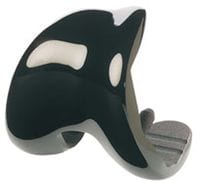Severe Arthrosis of the Knee Joint / Prosthetic Knees
If a knee joint has severe arthritis (often caused by an old injury or wear and tear on the joint) and minimally invasive surgical methods (e.g., knee arthroscopy) and medication have proven ineffective, then implantation of a prosthetic knee (knee replacement) can make sense, especially when the arthritis is inflicting severe pain and limiting mobility, thus significantly lowering the quality of life of the patient.
The optimal outcome of a knee replacement is the elimination of pain and full restoration of functionality, thus making sports and an active lifestyle possible once again.
In the past, implantation involved the removal of large sections of bone. Now it is more common to resect (shorten) only the damaged section of cartilage and to insert an artificial surface replacement - in principle similar to when a dentist caps a tooth with a crown instead of removing the entire root structure.


In order to achieve optimal results for his patients, Dr. Gäbler uses the most innovative method currently available: VISIONAIRE knee replacement technology. In this procedure, an MRI and specialized X-rays are made and sent to the USA, where a unique personalized cutting block is manufactured based on the patient’s personal data, creating a prosthetic that is specifically tailored to their body (the equivalent of a preoperative navigation and customized prosthetic knee). Studies have shown this method to be safer and much more accurate than traditional surgical methods (which have the difficulties of intraoperative navigation).
Another advantage of this method is that misalignments such as bow legs or knock knees can be measured with precision and, using computer calculations, corrected with 0% tolerance.
Dr. Gäbler exclusively uses prosthetic knees based on OXINIUM technology.

Oxinium is an extremely durable material. Studies show that Oxinium prosthetics have a life span of 30 years and more, while conventional prosthetic knees often wear out after only 10-15 years! Another advantage of Oxinium implants is that they contain almost no nickel, making them ideal for patients with nickel allergies. It is estimated that 3-8% of the population of western industrialized countries suffers from a metal sensitivity. Hypersensitive reactions, especially to nickel, often lead to postoperative complications with endoprosthetics. In is not uncommon for the cobalt-chromium alloys of common knee implants to contain up to 1% nickel. In contrast, the nickel content of Oxinium is less than 0.0035%, well below the detection threshold.
This means that Oxinium implants particularly suitable for patients with a nickel allergy.
Another major advantage of the custom implant planning process is that actual operation time is significantly shorter than with conventional surgical methods, since around 20 operation steps are made unnecessary. While the implantation of a conventional knee replacement often takes two hours or more, that of a custom-made Oxinium knee is usually finished in not more than 45 minutes. Closing the surgical incision sooner lowers the risk of infection, tremendously decreases dangers associated with anesthesia, and less blood is lost in comparison with conventional surgical methods.
This method makes it possible for the operation to be minimally invasive, reducing damage to muscular and soft tissue and thus resulting in faster rehabilitation.
Dr. Gäbler implanted the first Oxinium replacement in Austria years ago and hundreds of successfully operated patients have convinced him that this hardware and method provide the best results.
What happens after my knee has been replaced?
Rehabilitation begins the day of the operation. Depending on the time of the operation, you will be able to stand on your knee that very same day, or the day after at the latest - and you should! Not alone, of course, but with the help of a physical therapist or a member of our nursing staff.
It is possibly to put your full weight on your new knee immediately, provided the pain allows it. Dr. Gäbler adheres to a reliable pain management regimen that uses patient-controlled analgesia (pain pump) and intravenous therapy to ensure that pain is well tolerated in most cases.
Crutches will be needed for two to six weeks. The first phase of rehab starts in the hospital, with ice packs, physiotherapy, pain treatment, daily use of a continuous passive motion device (to improve mobility of the implanted joint), and lymph drainage.
During rehabilitation, careful attention must be paid to achieving both optimal flexion and extension, which can sometimes be a tedious process if movement has been restricted for several years.
As soon as the knee is able to bend 110°, the patient can begin ergometric training (home cycling). Outdoor cycling may not begin until six weeks after the operation at the earliest.
After the patient is discharged, physiotherapy must be continued. An intensive 3-week in-patient rehab stay with daily therapy is recommended about 6-8 weeks after the operation.
Playing sports with a knee implant
Playing sports and getting exercise are good for you after a knee replacement. The benefits that the entire organism gains from athletic activities (stimulation of the cardiovascular system, improved blood flow and coordination) outweigh the risks of injury. Patients with a knee replacement should, however, avoid sports with a very high risk of injury.
Dr. Gäbler recommends sports such as (Nordic) walking, swimming, rowing, golf, cross-country skiing, gymnastic exercise, yoga, hiking, cycling, and mountain biking. Moderate strength training is also recommended.
Jogging, skiing, tennis, and badminton are also allowed. However, Dr. Gäbler discourages running marathons and extreme downhill mountain biking.
It is strongly advised not to play rugby or hockey and not to do martial arts after a knee replacement.
One must be aware that knee implants exposed to extreme strain from intense running, football, etc. wear out faster and as a result may not last as long as would be desired.
Knee Replacement: Limitations and Contraindications
- NO cortisone injections for three months prior to the planned operation
- For diabetes: glycated hemoglobin (HbA1c) value must be < 7%
- Keine Einnahme von NSAR (Deflamat, Voltaren, Ibuprufen, u.ä.) für 10 Tage vor OP, wegen erhöhter Blutungsneigung bei NSAR Einnahme – alternative Schmerzmittel bei Bedarf bitte mit Operateur besprechen
- NO surgery if severe peripheral artery disease (PAOD) is present or if the blood flow to the area under operation is insufficient
- NO surgery if the BMI > 40
- NO surgery in case of serious illness (NO surgery for ASA III and IV)
- NO surgery in case of an existing infection (in the knee joint or other areas such as teeth (dental status must be checked) or toes)
- NO surgery if the skin around the operation area changes
- NO surgery if the leg has been shaved within the last 14 days
- NO surgery if the extensor mechanism is insufficient (mechanical or neurological)
- NO surgery in cases of immunodeficiency or immunosuppression (e.g. high-dose cortisone, biopharmaceuticals)
Preventing secondary infections after endoprosthesis implantation
- Consistent antibiotic prophylaxis prior to dental operations, colonoscopy, gastroscopy, etc.
- Antibiotic therapy for all bacterial infections
More questions?
Our experts are happy to help you
Just give us a call!





